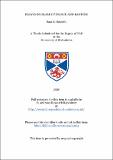Files in this item
Essays in Islamic finance and banking
Item metadata
| dc.contributor.advisor | Iannino, Maria Chiara | |
| dc.contributor.advisor | Abedifar, Pejman | |
| dc.contributor.author | Al Balooshi, Sara | |
| dc.coverage.spatial | ix, 228 p. | en_US |
| dc.date.accessioned | 2020-06-29T15:18:15Z | |
| dc.date.available | 2020-06-29T15:18:15Z | |
| dc.date.issued | 2020-07-31 | |
| dc.identifier.uri | https://hdl.handle.net/10023/20174 | |
| dc.description.abstract | This thesis comprises three essays on Islamic investment securities (sukuk) and Islamic banking products. Data show that firms in dual financial system economies utilize traditional and Islamic instruments simultaneously to raise funds. Hence, religion is not the sole motive for Islamic transactions. That is attributed to the structure of sukuk, either promoting transparency or obscuring firm information. Chapter II investigates the relationship between firms' opacity and the choice to issue sukuk, given the availability of traditional external sources. We find that as opacity increases, the probability of firms' issuing zero-coupon (ZC) sukuk is the highest followed by conventional bonds and profit-loss sharing (PLS) sukuk. Therefore, opacity has a significant role in choosing between traditional and Islamic instruments, and that issuing zero-coupon sukuk requires more supervision. Chapter III uses a modified pecking order theory to place sukuk in firms' financial hierarchies among debt and equity. We look at the firms' funding choices at two thresholds: exhaustion of internal funds and maximum debt capacity. Firms' choice indicates the level of adverse selection and information asymmetry involved in issuing sukuk. When internal funds are exhausted, firms prefer to issue Profit-loss sharing sukuk over bonds, and fixed income sukuk is placed before equity beyond firms' maximum leverage. Thus, sukuk can widen the external funding spectrum, and the modified pecking order can accommodate sukuk. Chapter IV looks at the investors of such instruments. We investigate the Islamic banks' product mix to verify the claim that Islamic banks are identical to conventional banks due to the concentration of debt-like products. We hand-collected the values of each Islamic banking product otherwise aggregated under "loans". We document that while debt-like products positively affect bank performance, profit-loss sharing products enhance solvency. Contrary to theoretical claims, Islamic banks portfolios are not concentrated. Chapter I introduces Islamic finance and products, while Chapter V concludes. | en_US |
| dc.description.sponsorship | "I owe a great debt to the University of Bahrain for the financial support." -- Acknowledgements | en |
| dc.language.iso | en | en_US |
| dc.publisher | University of St Andrews | |
| dc.subject | Corporate capital structure | en_US |
| dc.subject | Islamic finance | en_US |
| dc.subject | Islamic banking | en_US |
| dc.subject | Opacity | en_US |
| dc.subject | Pecking order | en_US |
| dc.subject | Sukuk | en_US |
| dc.subject | Product mix | en_US |
| dc.subject | Financial econometrics | en_US |
| dc.subject | Emerging markets | en_US |
| dc.subject | GCC | en_US |
| dc.subject | Portfolio concentration | en_US |
| dc.subject.lcc | HG3368.A6A63 | |
| dc.subject.lcsh | Banks and banking--Religious aspects--Islam | en |
| dc.subject.lcsh | Finance (Islamic law) | en |
| dc.subject.lcsh | Islam--Economic aspects | en |
| dc.subject.lcsh | Capital market--Islamic countries | en |
| dc.subject.lcsh | Capital market (Islamic law)--Malaysia | en |
| dc.title | Essays in Islamic finance and banking | en_US |
| dc.type | Thesis | en_US |
| dc.contributor.sponsor | Jāmiʻat al-Baḥrayn | en_US |
| dc.type.qualificationlevel | Doctoral | en_US |
| dc.type.qualificationname | PhD Doctor of Philosophy | en_US |
| dc.publisher.institution | The University of St Andrews | en_US |
| dc.publisher.department | University of Bahrain | en_US |
| dc.identifier.doi | https://doi.org/10.17630/10023-20174 |
This item appears in the following Collection(s)
Items in the St Andrews Research Repository are protected by copyright, with all rights reserved, unless otherwise indicated.

